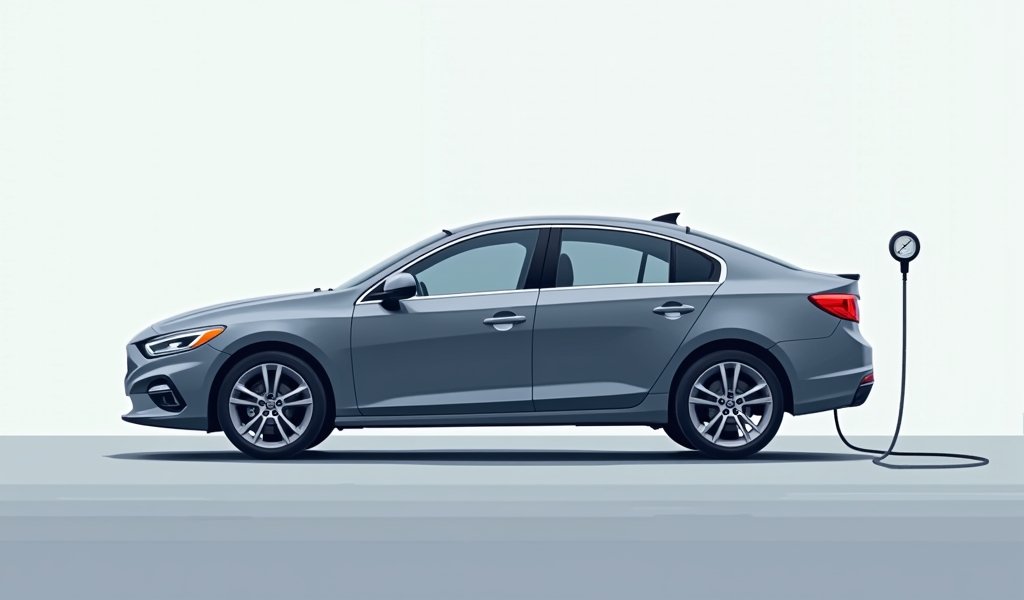Overview
Proper tire pressure maintenance is essential for vehicle safety, fuel efficiency, and tire longevity, with underinflated tires reducing gas mileage by 0.2% per PSI and potentially causing handling issues. The article provides a complete guide on finding recommended pressures, choosing the right gauge, checking tires when cold, using proper measurement techniques, and establishing a monthly checking routine that can save hundreds in fuel costs while extending tire life.
Table of Contents
- The Importance of Proper Tire Pressure
- Finding Your Vehicle’s Recommended Tire Pressure
- Choosing the Right Tire Pressure Gauge
- The Best Time to Check Your Tire Pressure
- Proper Technique for Checking and Adjusting Tire Pressure
- Establishing a Regular Checking Schedule
- Additional Tire Maintenance Tips for Better Mileage
- Conclusion
- Frequently Asked Questions
The Importance of Proper Tire Pressure
Let me tell you something I’ve learned after 20 years in the garage – those four patches of rubber connecting your vehicle to the road deserve more attention than most drivers give them. Proper tire pressure isn’t just a recommendation; it’s essential for your safety, vehicle performance, and wallet.
When your tires are underinflated, even by just a few PSI, your vehicle’s handling becomes compromised. Your stopping distance increases, cornering becomes less predictable, and in wet conditions, you’re at greater risk of hydroplaning. I’ve seen too many preventable accidents that started with neglected tire pressure.
But safety isn’t the only concern. According to the U.S. Department of Energy, you lose about 0.2% in fuel economy for every 1 PSI drop below your recommended pressure. That might not sound like much, but if all four tires are 10 PSI low, you’re effectively throwing away 8% of your fuel budget – about 24 cents per gallon at today’s prices!
Underinflated tires also wear out faster and unevenly. I’ve had customers need new tires thousands of miles earlier than necessary simply because they never checked their pressure. That’s hundreds of dollars wasted that could have been prevented with a $10 gauge and five minutes of monthly maintenance.
The good news? Checking and maintaining your tire pressure is one of the easiest DIY car maintenance tasks you can perform. No special skills required – just a little knowledge and the right tools.
Finding Your Vehicle’s Recommended Tire Pressure
Here’s a common mistake I see in my shop all the time: folks looking at the sidewall of their tire to determine the correct pressure. That number (usually something like “Max Press 51 PSI”) is actually the maximum pressure the tire can safely hold, not what your vehicle needs!
Your car’s engineers carefully calculated the optimal tire pressure based on your vehicle’s weight distribution, handling characteristics, and load-carrying capacity. This “sweet spot” gives you the best balance of traction, comfort, fuel economy, and tire longevity.

To find your vehicle’s recommended tire pressure:
- Check the driver’s side door jamb first. Open your driver’s door and look for a white or yellow sticker on the door edge, pillar, or doorjamb. This sticker lists the correct pressure for both front and rear tires (they’re sometimes different!).
- If you can’t find the sticker, check your owner’s manual. It’s usually listed in the maintenance or specifications section.
- Still no luck? Your vehicle manufacturer’s website often has this information in their support section.
Write down both the front and rear recommended pressures. Some vehicles, particularly those with larger engines in the front, specify slightly different pressures for front versus rear tires to optimize handling.
Remember that these recommended pressures assume “cold” tires – more on that critical detail soon. And if you frequently carry heavy loads or tow trailers, consult your owner’s manual for adjusted pressure recommendations under those conditions.
Choosing the Right Tire Pressure Gauge
A good pressure gauge is a lifetime investment that pays for itself many times over. I’ve tried dozens over my career, and while you don’t need to spend a fortune, the cheapest options usually lead to frustration and inaccurate readings.
There are three main types of tire pressure gauges you’ll encounter:
- Stick gauges: These pencil-shaped tools are the most affordable ($5-10) and compact. A small measuring stick pops out when pressed against the valve stem. They’re decent for occasional use, but can be harder to read accurately and tend to lose calibration if dropped.
- Dial gauges: These feature a circular gauge with a needle that points to the pressure reading. Good dial gauges ($15-25) offer better precision and easier reading. Some include a bleeder valve to release excess air. They’re bulkier but more durable than stick gauges.
- Digital gauges: My personal recommendation for most drivers. Digital gauges ($10-30) give precise readings on an LCD display, often with backlight for nighttime use. They remove any guesswork in reading the measurement and many automatically shut off to preserve battery life.
Whichever style you choose, look for these features:
- A secure, leak-free seal when pressed against the valve stem
- A comfortable grip that’s easy to hold at awkward angles
- A pressure range that exceeds your vehicle’s needs (usually 5-60 PSI is plenty for passenger vehicles)
- Durability – a gauge that can handle being dropped occasionally
I recommend keeping your gauge in your glove compartment rather than rolling around in a toolbox where it might get damaged. And if you haven’t checked your gauge’s accuracy in years, consider testing it against a known accurate gauge (like the one at a professional shop during your next car service) or simply investing in a new one.
The Best Time to Check Your Tire Pressure
Timing matters tremendously when checking tire pressure. The golden rule is to check your tires when they’re “cold” – and no, I don’t mean when it’s chilly outside!
In the context of tire pressure, “cold” means the tires haven’t been driven on for at least 3 hours. When you drive, friction heats up the air inside your tires, causing it to expand and increasing the pressure reading by 2-6 PSI. If you check hot tires and adjust to the recommended cold pressure, you’ll actually be underinflating them once they cool down.
The ideal time to check tire pressure is first thing in the morning before driving anywhere. If that’s not practical, try to let your vehicle sit for at least 3 hours before checking. If you must check warm tires, the rule of thumb is to add 4 PSI to your vehicle’s recommended cold pressure as your target.
Remember that ambient temperature affects tire pressure too. For every 10°F drop in temperature, tire pressure decreases by about 1 PSI. This is why your tire pressure warning light often comes on during the first cold snap of autumn – your tires didn’t suddenly develop leaks; the air inside just contracted with the temperature drop.
Conversely, during summer heat waves, your pressure can increase beyond recommended levels. While slight overinflation isn’t as immediately dangerous as underinflation, it does reduce your tire’s contact patch with the road, potentially affecting traction and causing premature wear in the center of the tread.
The takeaway? Check more frequently during seasonal transitions, and don’t be surprised if you need to add air in fall/winter and release some in late spring/summer.
Proper Technique for Checking and Adjusting Tire Pressure

Now let’s walk through the actual process of checking and adjusting your tire pressure. It’s straightforward once you know the proper technique:
- Remove the valve cap and place it somewhere secure – in your pocket or on a clean surface where it won’t roll away. (Those little caps matter more than you think – they keep dirt and moisture out of the valve mechanism).
- Press your gauge firmly onto the valve stem. You’ll hear a brief hiss as the connection is made, but a proper seal shouldn’t allow continuous air loss.
- Hold the gauge straight on the valve – angling it will give inaccurate readings and can allow air to escape.
- Read the pressure displayed. Digital gauges show the reading immediately, while stick gauges need to be removed to view the measurement.
- Compare the reading with your vehicle’s recommended pressure.
If your pressure is too low, you’ll need to add air:
- Drive to a gas station with an air compressor. Many stations offer free air, while others charge $1-2.
- Position your vehicle so you can easily reach all four tires with the air hose.
- Remove the valve caps from all tires (doing them one at a time reduces the chance of losing caps).
- Press the air hose nozzle firmly onto the valve stem. You’ll hear air flowing in.
- Add air in short bursts (2-3 seconds), then remove the nozzle and check the pressure with your gauge. It’s better to add small amounts and recheck than to overinflate.
- Once you reach the recommended pressure, replace the valve cap securely.
- Repeat for all tires.
If your pressure is too high:
- Press the small pin in the center of the valve stem using the back of your gauge, a valve tool, or even a clean pen cap. You’ll hear air escaping.
- Release air in small bursts (1-2 seconds) and recheck.
- Continue until you reach the recommended pressure.
Don’t forget to check your spare tire! Whether you have a full-size spare or a temporary “donut,” it needs proper inflation to be useful in an emergency. Temporary spares often require much higher pressure (around 60 PSI) than regular tires, so check your owner’s manual for the correct specification.
Establishing a Regular Checking Schedule
In my experience, the biggest obstacle to proper tire maintenance isn’t knowledge or tools – it’s simply remembering to do it. Even perfectly sealed tires naturally lose about 1-2 PSI per month through microscopic pores in the rubber and tiny leaks around the rim seal.
Here’s the checking schedule I recommend to my customers:
- Check all tires (including the spare) once per month at minimum
- Always check before long road trips
- Check after significant temperature changes (especially in fall and spring)
- Check if your vehicle has been sitting unused for more than a couple weeks
The easiest way to remember is to tie your tire checks to another regular event. Some folks do it on the first day of each month. Others make it part of their routine during every other fill-up. I personally check mine during my weekend car wash.
Setting a recurring reminder on your phone works wonders too. Five minutes once a month can save you hundreds in fuel and premature tire replacements – not to mention potentially avoiding an accident caused by underinflated tires.
If your vehicle has a Tire Pressure Monitoring System (TPMS), don’t rely on it exclusively. Most systems only alert you when pressure drops 25% below the recommended level – by which point you’re already experiencing reduced fuel economy and increased wear. Consider the warning light your last line of defense, not your primary monitoring method.
Make tire pressure checks part of your car inspection checklist routine. While you’re at it, visually inspect your tires for uneven wear, bulges, or objects embedded in the tread. A comprehensive approach to tire maintenance will extend their life considerably.
Additional Tire Maintenance Tips for Better Mileage
While proper inflation is the foundation of tire maintenance, several other factors affect how your tires impact fuel economy:
Tire Rotation: Even perfectly inflated tires wear differently depending on their position. Front tires on front-wheel-drive vehicles typically wear faster on the outside edges due to turning forces. Regular rotation (every 5,000-7,500 miles) ensures even wear across all tires, maximizing their lifespan and maintaining optimal rolling resistance.
Wheel Alignment: When your wheels aren’t properly aligned, your tires literally drag sideways down the road. This creates resistance that your engine must overcome with additional fuel. If your vehicle pulls to one side or your steering wheel isn’t centered when driving straight, it’s time for an alignment check. According to Car and Driver, proper alignment can improve fuel economy by up to 10% in severe cases.
Tire Balance: Unbalanced tires create vibration that you might feel in the steering wheel or seat. Beyond being uncomfortable, this vibration represents wasted energy and uneven tire wear. Have your tires balanced whenever you notice vibration or during tire rotation.
Consider Tire Type: When it’s time for new tires, consider low rolling resistance options. These tires are designed with special compounds and tread patterns that require less energy to roll down the road. The Consumer Reports testing shows they can improve fuel economy by 1-4% compared to standard tires. While they sometimes cost more initially, the fuel savings often offset the price difference over their lifetime.
Watch for Tire Age: Rubber compounds harden as they age, reducing traction and increasing rolling resistance. Even if they have adequate tread, tires over 6 years old should be inspected annually by a professional, and those over 10 years old should generally be replaced regardless of appearance.
Remember that proper tire pressure amplifies the benefits of all these other maintenance items. Think of it as the foundation – get the pressure right first, then build on that with these additional practices for maximum efficiency and tire life.
Conclusion
Properly maintained tire pressure isn’t just about saving a few dollars on gas – though that’s certainly a nice benefit. It’s about maximizing your vehicle’s safety, handling, and reliability while extending the life of one of your car’s most expensive wear items.
The five minutes you spend each month checking your tire pressure delivers an incredible return on investment. You’ll enjoy better fuel economy, more predictable handling, longer-lasting tires, and the peace of mind that comes with knowing you’ve reduced your risk of a blowout or accident.
Remember the key takeaways: know your vehicle’s recommended pressure (not the maximum on the sidewall), invest in a quality gauge, check when tires are cold, use proper technique, and establish a regular checking routine. These simple habits separate those who get the most from their vehicles from those who wonder why they’re always at the pump or tire shop.
While modern vehicles with tire pressure monitoring systems have made maintenance easier, nothing replaces the hands-on check with a reliable gauge. Your TPMS is a backup, not a replacement for regular manual checks.
I’ve spent decades in the garage, and I can tell you that the customers who check their tire pressure regularly almost always spend less on fuel, tires, and unexpected repairs than those who ignore this simple maintenance task. It’s one of the easiest ways to be good to your vehicle – and your vehicle will return the favor with years of reliable service.
Frequently Asked Questions
Can I check tire pressure at a gas station without my own gauge?
Yes, many gas station air machines include built-in gauges, but their accuracy can be questionable due to heavy use and abuse. For best results, invest in your own quality gauge and use the station’s air compressor just for inflation.
Should I inflate my tires to the pressure listed on the sidewall?
No, the sidewall shows the maximum pressure the tire can safely hold, not what your vehicle needs. Always use the recommended pressure listed on your vehicle’s door jamb sticker or in the owner’s manual.
How much does tire pressure affect gas mileage?
Significantly – underinflated tires can reduce fuel economy by up to 0.2% per PSI below recommendation. If all four tires are 10 PSI low, you could be wasting up to 8% of your fuel.
Do I need to check my tire pressure in winter?
Absolutely, and more frequently than in summer. Tire pressure drops approximately 1 PSI for every 10°F decrease in temperature, so cold snaps can quickly leave you with underinflated tires.
What’s the easiest way to remember to check tire pressure?
Tie it to another regular event like monthly bill payments, car washing, or oil changes. Setting a recurring monthly reminder on your phone is also highly effective.


Pingback: Best Portable Tire Inflator: Top 5 Picks - knowsyourcar.com